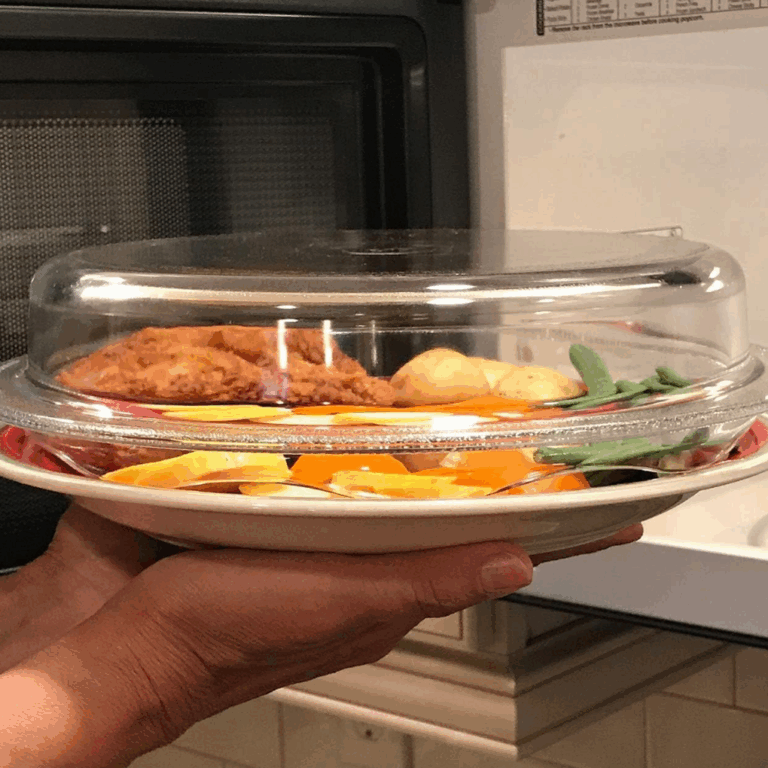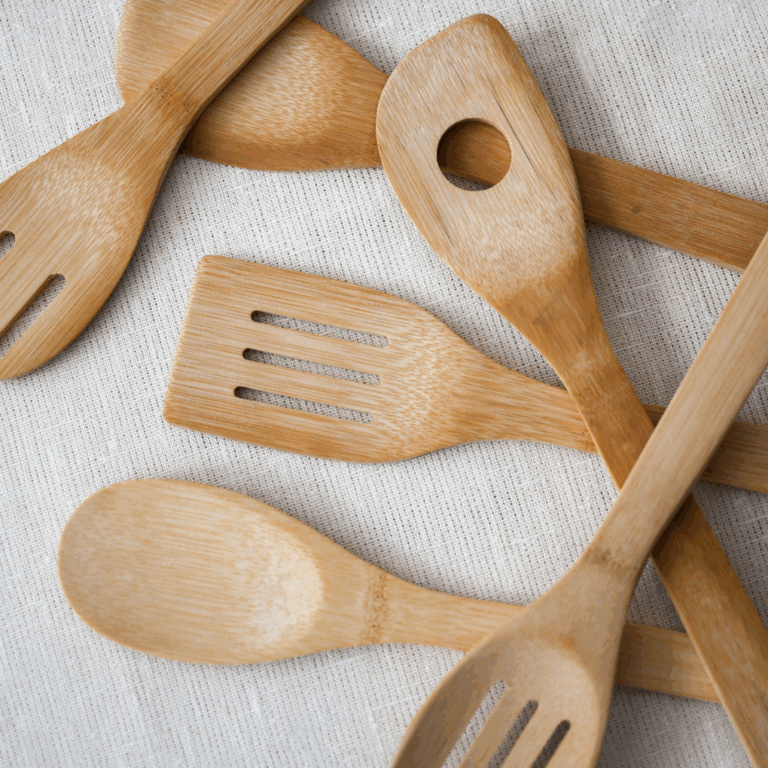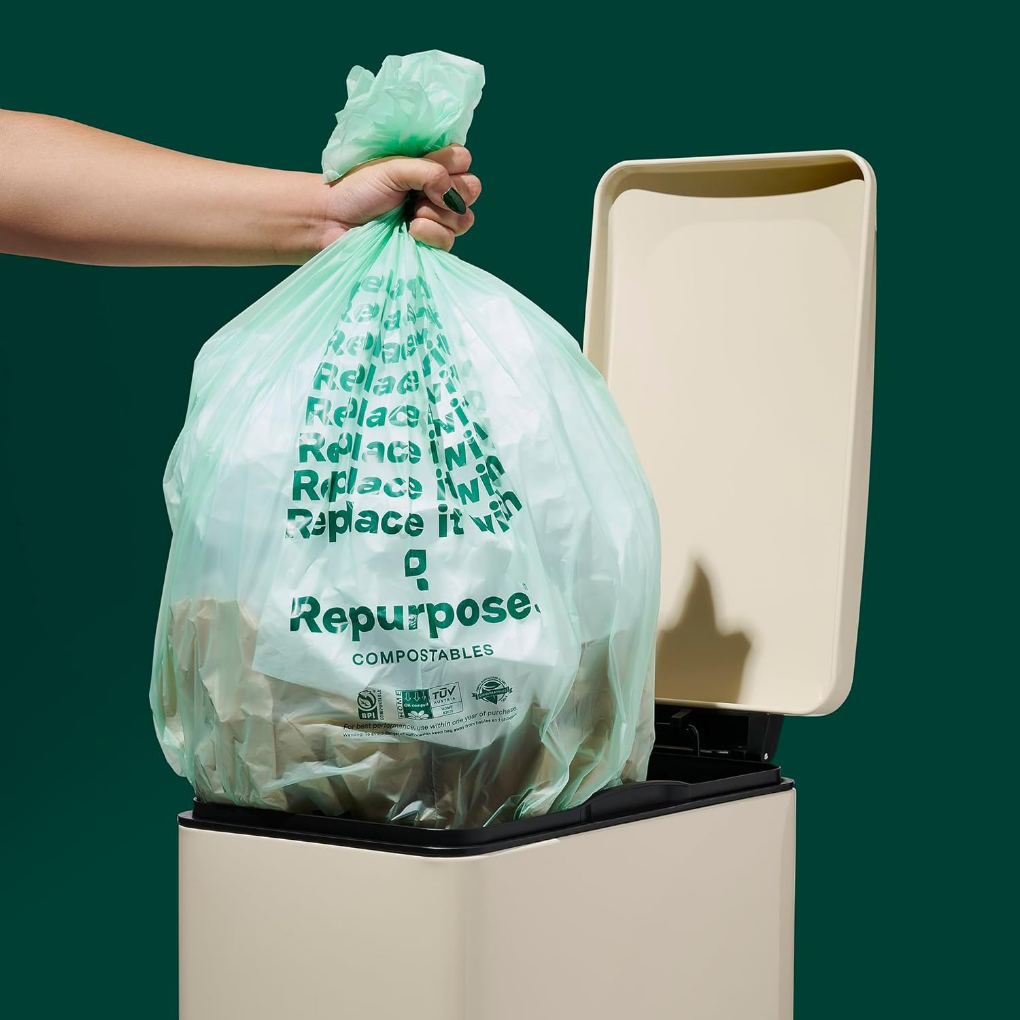
Key Takeaways
- Biodegradable garbage bags can leave microplastics behind, while compostable bags (ASTM D6400, BPI certified) fully break down into safe, natural materials.
- Composting facilities decompose bags in weeks, but in landfills they can last for decades and sometimes never fully break down.
- Plant-based materials like cornstarch or sugarcane, combined with certifications such as OK Compost and BPI, make for the most eco-friendly bag choices.
Did you know that between 500 billion and 1 trillion plastic bags are used globally every year? That’s up to 1 million bags every minute, and most of them remain in landfills for 500 years or more, slowly breaking down into harmful microplastics.
That’s why many people are switching to biodegradable garbage bags. They’re not perfect, but when used correctly, they help cut down plastic pollution and protect wildlife, water, and land. Here’s what you need to know before choosing the right bag.
What’s the Difference Between Compostable and Biodegradable Bags?
Biodegradable bags and compostable bags are both marketed as eco-friendly alternatives to plastic. Still, standards like ASTM D6400 and BPI Certification prove that only compostable bags are designed to break down into safe materials fully.
- Biodegradable Bags: These break down faster than traditional plastics but still depend on heat, moisture, and microorganisms. In a landfill, they can last for decades and sometimes leave toxic residues.
- Compostable Bags: Certified under ASTM D6400 and BPI Certification, these bags are designed to fully break down into safe, natural materials when processed in industrial composting systems.
If you’re collecting kitchen scraps or organic waste for curbside compost, compostable bags are the safest choice. If you’re looking for a lower-impact option for general trash, biodegradable bags are still better than regular plastic—but only in the right conditions.
What Makes a Trash Bag Eco-Friendly
Not all “green” trash bags are created equal. Here’s what really matters when deciding if a bag is truly eco-friendly:
Renewable Materials
Look for bags made with cornstarch, PLA (polylactic acid), or other plant-based materials instead of petroleum-based plastics. These renewable resources reduce our reliance on fossil fuels and typically break down more quickly.
Certifications
Trusted certifications prove the bag has been tested to actually decompose without leaving harmful residues.
- ASTM D6400: The U.S. standard for compostable plastics
- BPI Certification: Independent third-party verification for composability
- UL ECOLOGO: A broader sustainability standard for reduced environmental impact
Recycled Content
Some eco-friendly trash bags are made from plastic that has already been used and recycled. This is called post-consumer recycled plastic. Instead of throwing that plastic away, it gets turned into new bags through a closed-loop recycling system. It reduces waste and gives old plastic a second life.
Supportive Policies
In many cities and states, laws now limit or ban the use of single-use plastic bags. To meet these rules, compostable and biodegradable bags are often encouraged as alternatives. These policies make it easier for households and businesses to choose more sustainable options.
Carbon Footprint
Bags made from plant-based or recycled materials typically require less energy to produce. That means they use fewer fossil fuels and release less carbon dioxide into the air. Over time, choosing these types of bags helps lower their impact on the climate.
Even with all these improvements, remember: every disposable bag still creates waste. The most eco-friendly choice is to reduce the number of bags you use whenever possible by reusing liners, skipping liners for dry trash, or washing out your bin.
How Long Do Biodegradable Garbage Bags Take to Decompose?
Biodegradable garbage bags can break down in just weeks in industrial composting facilities, but may last for decades in landfills without air, moisture, or microbial activity.
🔥 Hot, moist composting facilities
In commercial composting facilities, where heat and moisture are carefully managed, biodegradable and compostable bags can break down in just a few weeks to a few months. These facilities are designed to keep microorganisms active, which significantly accelerates decomposition.
❄️ Cool or dry conditions
In cooler or drier climates, biodegradable bags take significantly longer to break down. Without sufficient heat or moisture, the tiny organisms that break them apart cannot perform their job as effectively. As a result, it can take many months or even years for a bag to decompose completely.
🏔️ Landfills
Landfills are the most challenging environment for biodegradable bags to break down. They are packed so tightly that neither air nor sunlight can reach inside, and both are necessary for the decomposition process. Under these conditions, bags can last for decades, and some may never fully decompose. Instead, they might turn into tiny pieces of plastic called microplastics.
✨ Tip
Composting Program
If your city offers a composting program, that’s the best place to send compostable bags. For example, where I live in Seattle, we have free composting services that make it easy to put food scraps and compostable bags in the green bin. In a landfill, these bags won’t live up to their eco-friendly promise.
How to check your city’s composting options:
- Visit your city’s official website or sanitation department page.
- Look for terms like “curbside composting,” “food scrap collection,” or “drop-off composting.”
- And if you can’t find anything online, try contacting your local waste services and asking if compostable bags are accepted in their program.
When your compostable bag ends up at a real compost facility instead of at a landfill, it actually breaks down like it’s supposed to.
Recommended Biodegradable and Compostable Garbage Bag Brands
Here are some trusted brands to consider. While many are marketed as “biodegradable,” the best options are usually certified compostable and designed to break down fully under the right conditions. Since that’s what most people are really looking for when they search for biodegradable bags, the picks below highlight compostable choices.
Repurpose
$20-30

Repurpose is one of the best-known brands in compostable bags. Their kitchen and small-bin bags are certified compostable for industrial facilities under ASTM D6400 and BPI standards, and many are also approved for home composting through OK Compost Home and Lomi.
They also carry CMA Composter Approved certification, which confirms wide acceptance in commercial composting programs. Together, these certifications guarantee the bags will break down entirely and safely under the right conditions.
Key Features
- Made from renewable materials: These bags use cornstarch and other plant-based ingredients. They’re non-toxic, BPA-free, and safe for the environment.
- Durability: Reviewers note that Repurpose bags hold up well against leaks and tears when used for food scraps, yard clippings, or pet waste.
- Company values: Repurpose has been carbon-neutral for years and continues to focus on reducing plastic pollution through everyday products.
What Customers Say
Many say they hold up well for food scraps and kitchen use, with some sharing clever hacks, such as separating wet scraps in a smaller bag to prevent tearing.
A few reviewers were surprised at how sturdy they are compared to regular plastic bags and plan to switch permanently.
That said, not everyone had a perfect experience. Some found the bags too thin for heavy or sharp trash, noticed leaks in warmer months, or wished they came with twist ties. A small number of users said the bags tore too easily or fell apart.
Simply Bio
$18
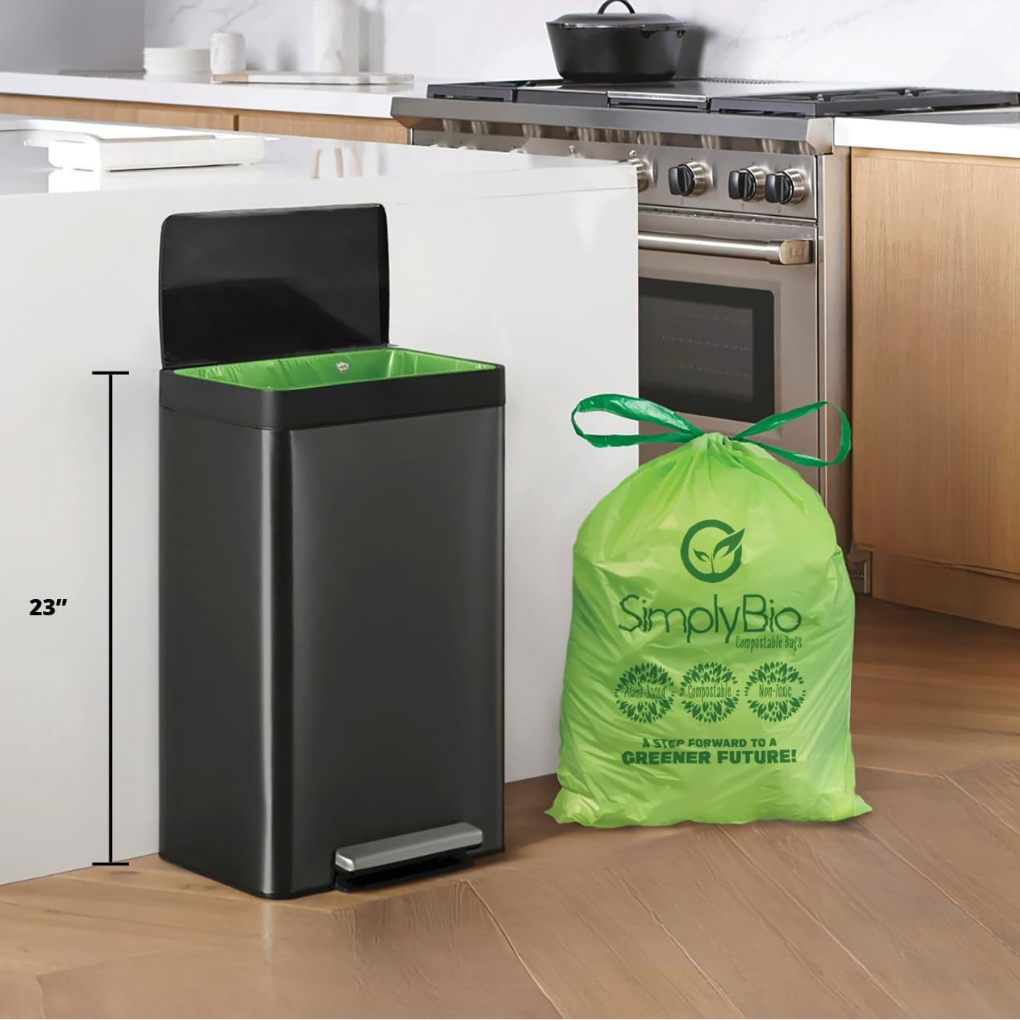
Simply Bio produces compostable trash bags that meet the needs of nearly every eco-conscious household.
These bags are made from plant-based materials and come with some of the strongest certifications available: BPI Certified for industrial composting, OK Compost Home for backyard composting, and the Seedling certification from TÜV Austria for municipal composting programs.
That means whether you’re using a curbside compost bin or a backyard pile, Simply Bio bags are designed to break down fully and safely.
Key Features
- Certified compostable: Works in both commercial composting facilities and home compost systems.
- Plant-based materials: Made from renewable resources instead of petroleum-based plastics.
- Variety of sizes: Available in kitchen, bathroom, and yard waste sizes, making them versatile for different household needs.
- Safe and non-toxic: Designed to leave no harmful residues behind once composted.
What Customers Say
Most customers are pleased with these compostable drawstring bags, praising their strength, ease of use, and eco-friendly design. The drawstrings make them easy to tie and carry, and many reviewers report that they fit kitchen cans well without slipping or leaking.
While some users reported tearing when the bags were overfilled or stretched, and others mentioned the higher cost compared to plastic, most agreed they hold up well for composting and light household trash.
Hippo Sak
$19
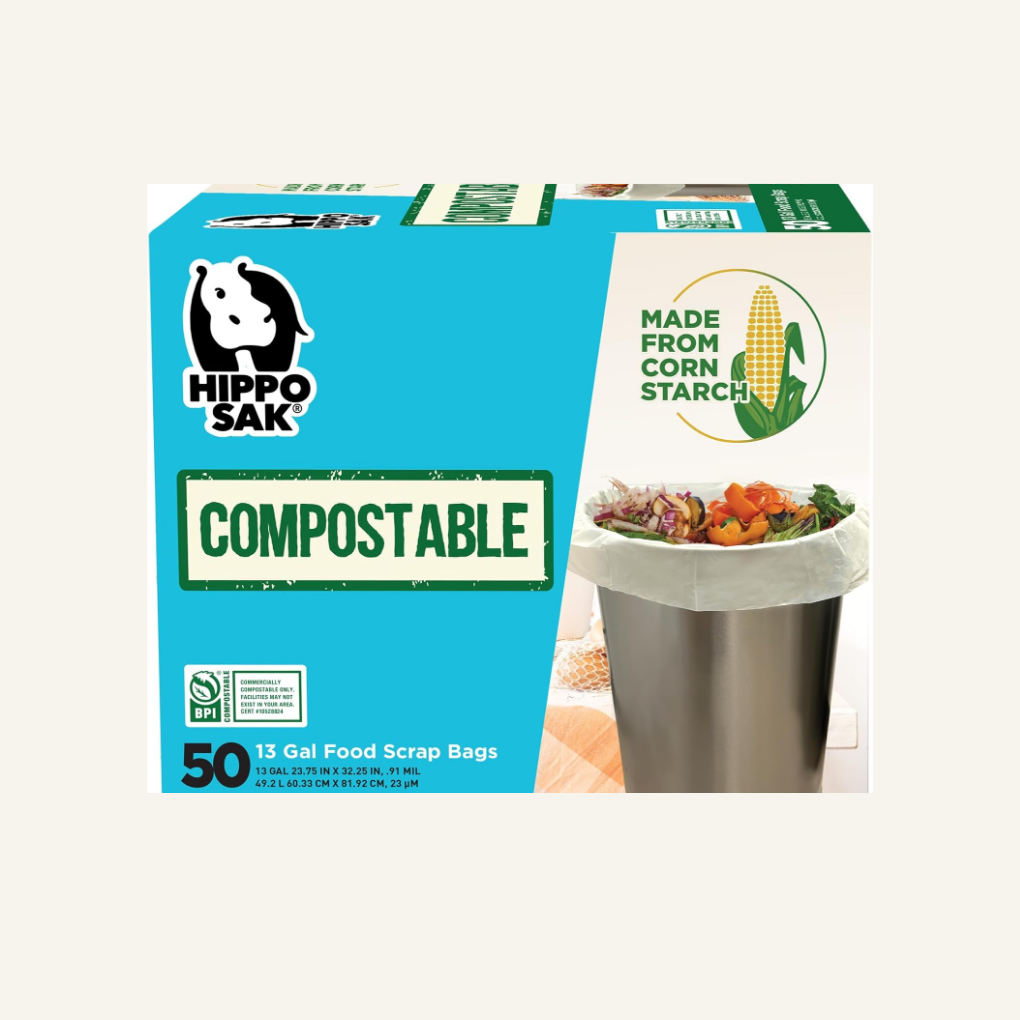
Hippo Sak offers a greener take on the everyday kitchen trash bag. Instead of being made entirely from petroleum-based plastic, these 13-gallon bags are made from plant-based sugarcane material and carry the USDA Certified Biobased Product label. That means they’ve been verified to contain a high percentage of renewable, plant-based content.
Key Features
- Durable design: Hippo Sak bags are leak- and puncture-resistant, with reinforced bottoms and ergonomic handles that make them easier to carry and tie.
- Plant-based materials: About 80% of each bag comes from renewable sugarcane, which helps lower the carbon footprint compared to traditional plastic bags.
- Made in the USA: Production uses renewable energy where possible, further reducing environmental impact.
What Customers Say
Most reviewers praise these compostable bags for being durable, leak-free, and much stronger than expected, with several people noting they can handle food scraps without tearing or making a mess. Many long-time users report that the quality is consistent and that the bags feel sturdier than those of other compostable brands.
At the same time, some customers found them too thin for heavy loads or noted that they break down too quickly if not emptied often. Others mentioned design drawbacks, such as the lack of drawstrings or difficulty staying in place in certain types of trash cans.
Overall, people like these bags for composting and light kitchen trash, but they’re not ideal for overstuffed bins or anyone on a tight budget.
BioBags
$13-26
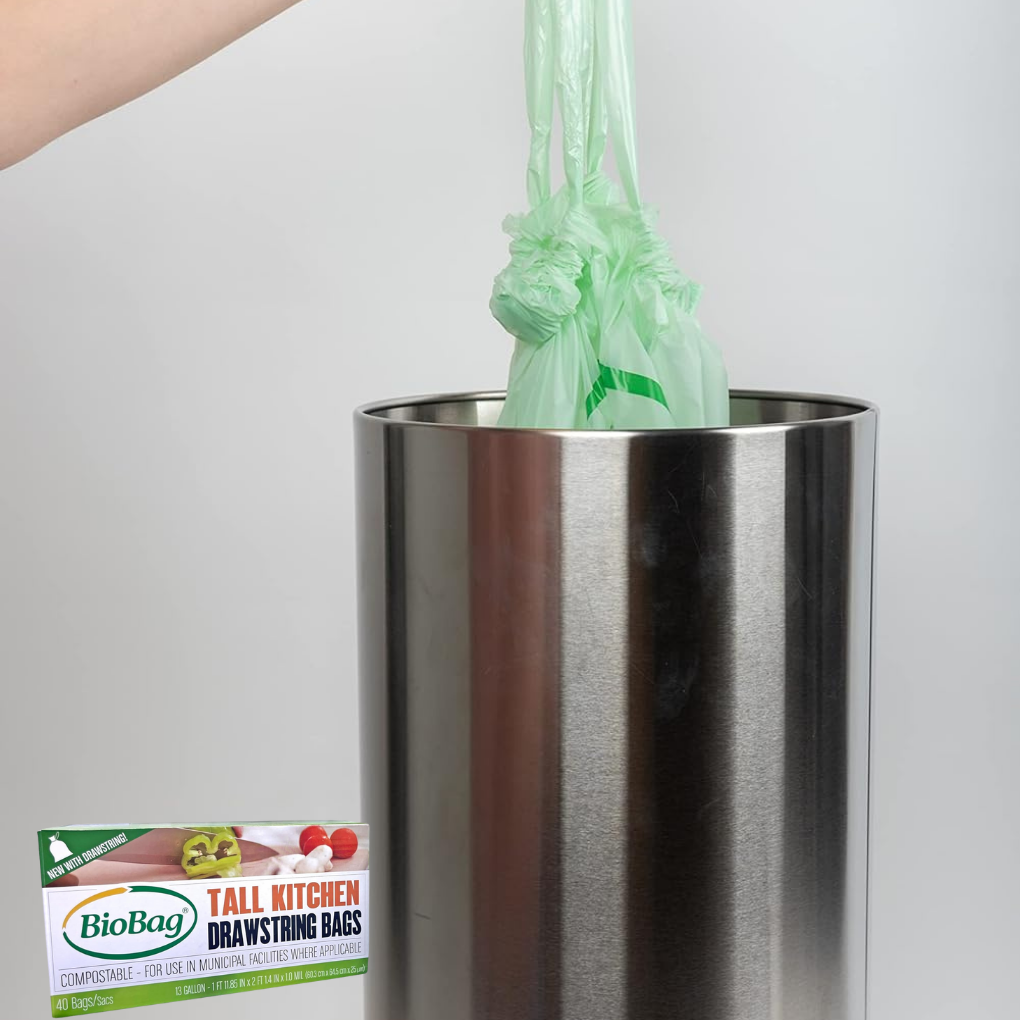
If you’re looking for a truly compostable garbage bag, BioBags are one of the most trusted names out there. Unlike “biodegradable” bags that may still leave behind microplastics, BioBags are made from cornstarch and vegetable oils and are certified under both ASTM D6400 and BPI standards. That means they’ve been tested to fully break down in a commercial composting facility without leaving toxic residue.
Key Features
- Plant-Based Materials: Instead of petroleum-based plastic, BioBags use renewable ingredients like cornstarch. This makes them better for the environment right from the start.
- Certified Compostable: The ASTM D6400 and BPI certifications are important because they guarantee the bags will decompose into safe, natural matter when processed in the right conditions.
- Designed for Organic Waste: These bags are thin but strong enough to hold kitchen scraps, fruit peels, coffee grounds, and yard waste. They’re not meant for heavy, sharp trash—but for food waste collection, they work perfectly.
What Customers Say
BioBags are a popular choice for anyone wanting a compostable alternative to plastic trash bags. Most people find them strong enough for food scraps, recycling, and kitchen compost bins, especially if they’re not overfilled.
Some reviewers did notice that they can tear with heavy or sharp trash and wished they came with ties; however, overall, users agree that they’re reliable for everyday composting and a good way to reduce plastic waste.
Green Earth
$14-38
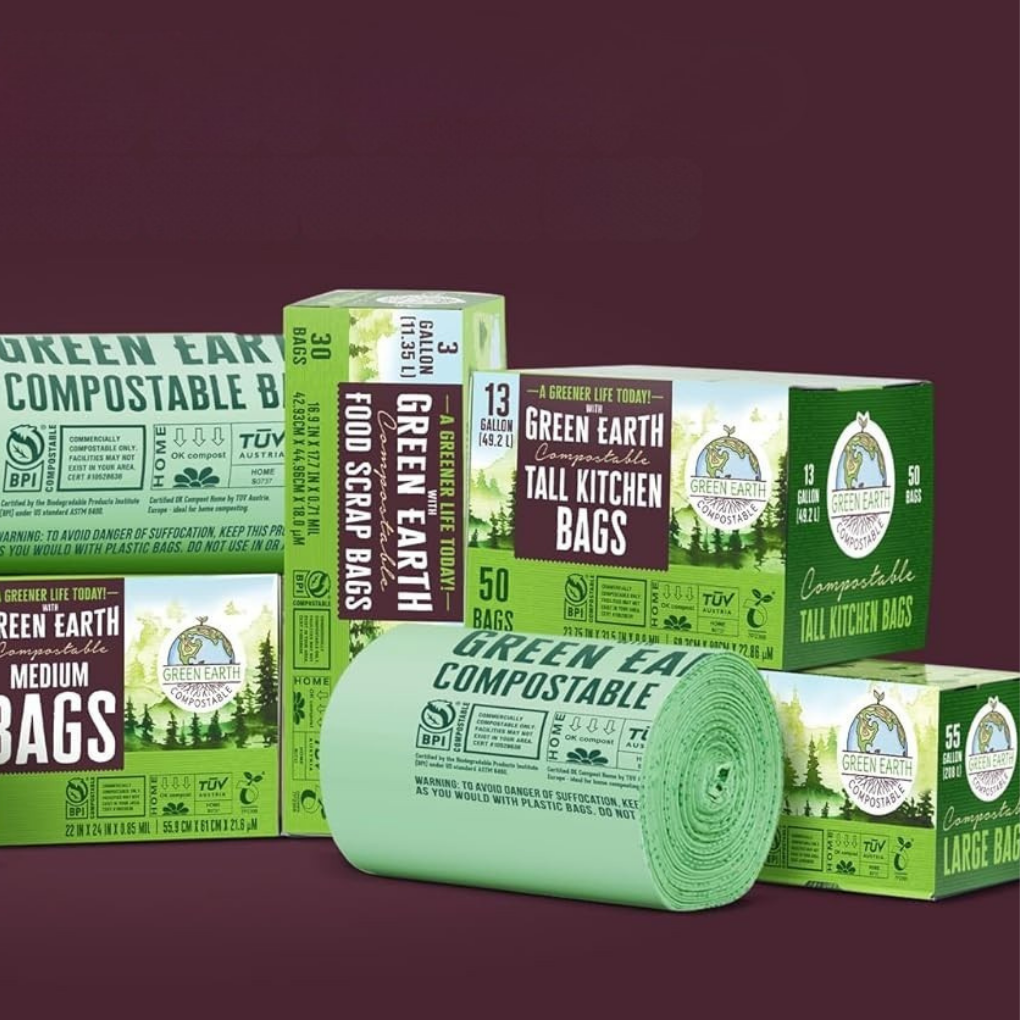
Green Earth makes compostable trash bags designed to work for both industrial composting facilities and home compost bins. They’re certified by both BPI (ASTM D6400) and OK Compost Home, so you can trust they’ll break down entirely and safely in the right conditions.
Key Features
- Certified compostable: Meets strict standards for commercial composting and is also approved for backyard compost use.
- Plant-based materials: Made from cornstarch and other renewable resources instead of petroleum-based plastics.
- Variety of sizes: Available in options for kitchen, bathroom, and yard waste bins.
- Trusted brand: Known for clear labeling and compliance with composting programs, making them widely accepted in many cities with green bin services.
What Customers Say
Many customers really like Green Earth compostable bags, saying they’re durable, easy to use, and fit well in kitchen bins. Reviewers praised them for not leaking, opening easily, and actually breaking down as promised. Several noted they’re sturdier than other compostable bags they’ve tried, and many felt better knowing they weren’t supporting single-use plastic.
On the downside, some users experienced tearing, sweating, or premature breakdown if the bags were stored too long or exposed to heat and moisture. Others mentioned that the bags don’t always decompose fully and that tying them off can be tricky without leaving extra space.
✨tips
How to Get the Most Out of Your Bags
Here are a few ways to get the most out of biodegradable and compostable bags:
- Buy only what you’ll use in a year: Biodegradable bags don’t last forever, most weaken after 12 to 18 months. Think of them like pantry staples: you wouldn’t stockpile more bread than you can eat before it goes stale, so only keep a supply of bags you’ll actually use.
- Store them properly: Heat and sunlight cause the materials to break down early. Store them in a cool, dry cupboard just like you would with flour or pasta, so they remain strong when you need them.
- Use the right bag for the right job: Do you have a compost bin in your kitchen? Compostable bags are perfect for catching fruit peels, coffee grounds, and dinner scraps. For bathroom or bedroom trash, where the waste is mostly paper or packaging, a recycled-content bag may be the better choice.
- Check your city’s composting rules: Some cities allow you to toss certified compostable bags directly into the green bin, while others require you to empty the food scraps and dispose of the bag separately. A glance at your local waste guidelines will help you avoid mistakes.
- Remember, they’re not a perfect solution: It’s tempting to think biodegradable bags solve the whole plastic problem, but they don’t. You can reduce waste even further by reusing liners for dry trash, rinsing out your trash can, or skipping a liner altogether in areas like your home office.
FAQs About Biodegradable Garbage Bags
Most don’t. Backyard compost piles usually stay cooler and drier than industrial facilities, which slows the breakdown process. Many biodegradable bags may only partially decompose or leave residue. Look for bags labeled “home compostable” (such as OK Compost Home certified) if you want a reliable option for backyard bins.
Certified compostable bags tested under ASTM D6400 or BPI standards are designed to turn into non-toxic organic matter, leaving no harmful residues. Non-certified “biodegradable” bags may still leave microplastics or chemical additives behind. For safety, stick with trusted certifications and avoid generic biodegradable claims.
Yes, compostable and biodegradable bags usually cost more upfront. However, prices are slowly dropping as demand increases, and many households offset the cost by using fewer bags overall. Some cities even provide discounts or free bags through composting programs, making the switch more affordable.
Not necessarily. Compostable bags are more breathable than plastic, which means moisture (and odors) can escape. If smells are a problem, try keeping food scraps in the freezer or fridge until collection day. Emptying bins more often also helps keep things fresh.
ASTM D6400 and BPI certification show that a bag will fully decompose in industrial composting facilities. If you plan to compost at home, look for OK Compost Home or similar labels designed for cooler backyard systems. Certifications like TÜV Austria also add credibility.
Most biodegradable and compostable bags last 12–18 months before they start breaking down in storage. Keep them in a cool, dry place away from sunlight and heat to extend their life. Buying only a year’s supply at a time helps prevent wasted bags.
Final Thoughts on Biodegradable Garbage Bags
Biodegradable and compostable garbage bags are not perfect, but they are still a better choice than regular plastic bags. The key is learning when and how to use them so they actually help the environment. Even small steps, such as selecting the right bag for the job, can make a significant difference over time.
If you’re dealing with food scraps or yard waste, compostable bags certified to standards such as ASTM D6400 and BPI are the best option. For everyday trash, biodegradable or recycled-content bags can cut down your impact compared to standard plastic.
But here’s the most important thing: even the “green” options are still single-use. The best step for the planet is to make each bag go further—like reusing liners for dry waste or rinsing out your bin so you don’t need to replace bags as often.
Making these small changes might not seem significant on their own, but they do add up. Choosing better trash bags is a straightforward way to reduce plastic pollution and live a little more sustainably every day.
Don’t Miss: Plastic-Free Living 👉 Discover why cutting back on plastic is one of the most important steps you can take for your health and the planet. Read more →💬What about you? Do you use compostable, biodegradable, or recycled bags in your home? Share your experience in the comments—I’d love to know what’s working for you.
Featured image from Amazon.
📚References
- Los Angeles County Department of Public Works. (2005, July 21). Plastic bag pollution (Fact Sheet). https://dpw.lacounty.gov/epd/plasticbags/articles/googobits_07-21-05.pdf
- Plastic Oceans International. (n.d.). Plastic pollution facts. https://www.plasticoceans.org/blog/the-facts
